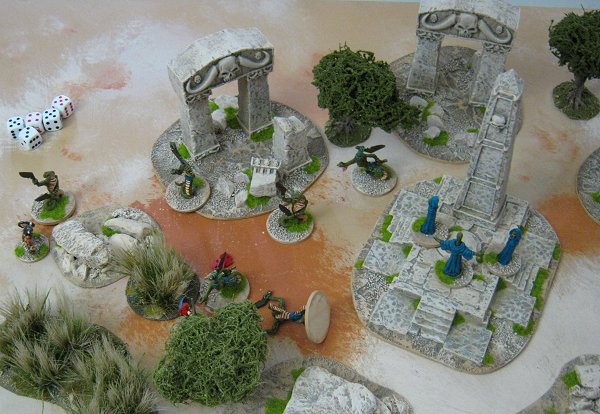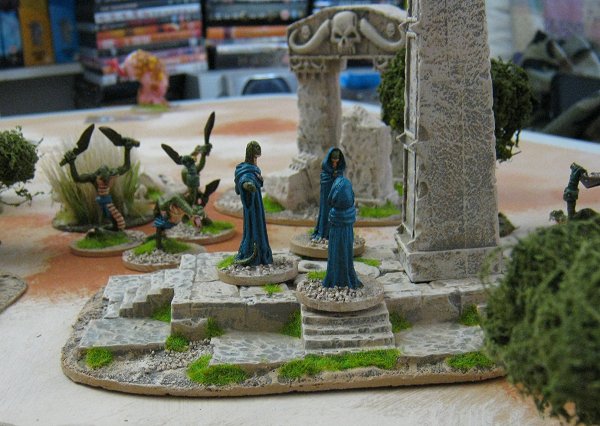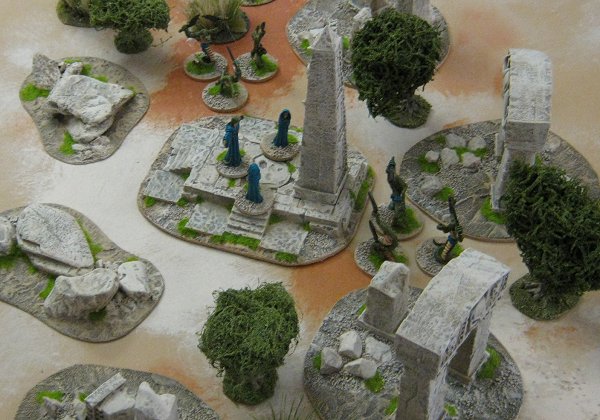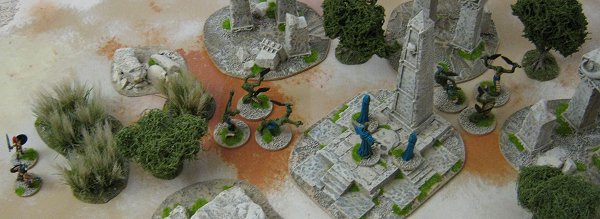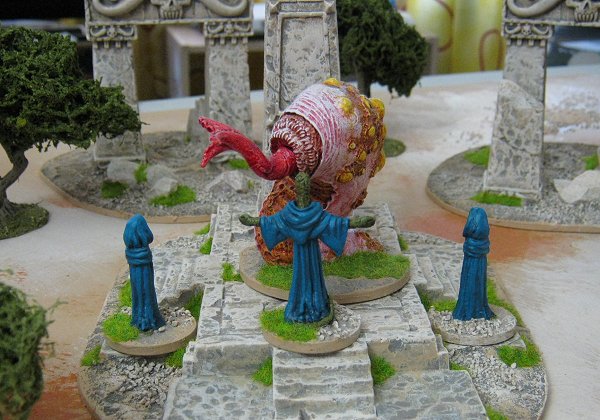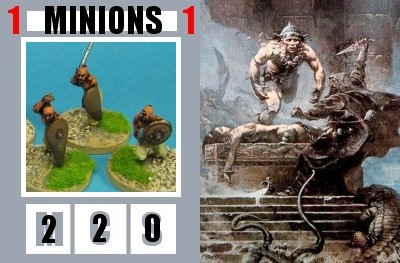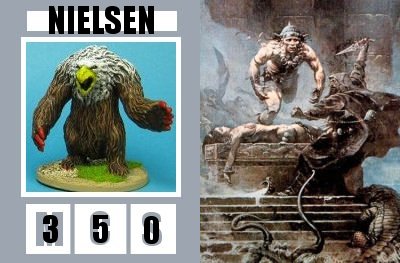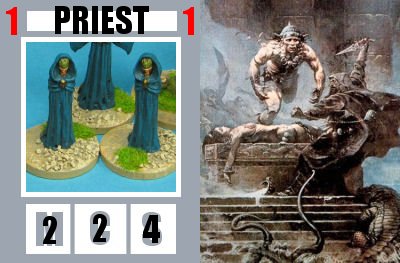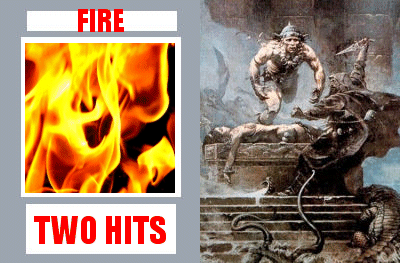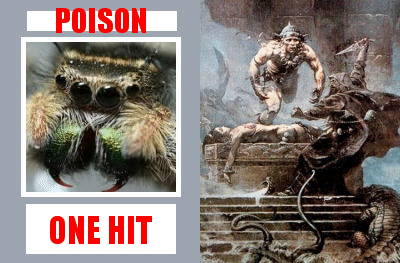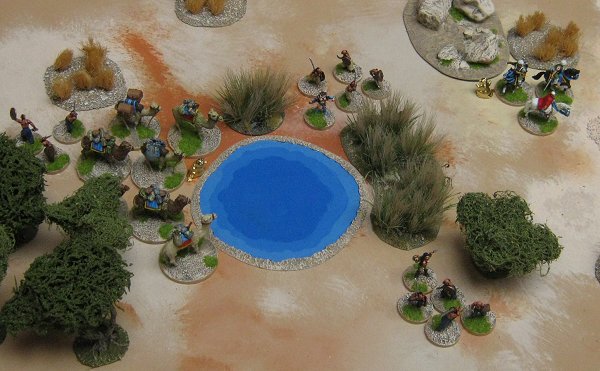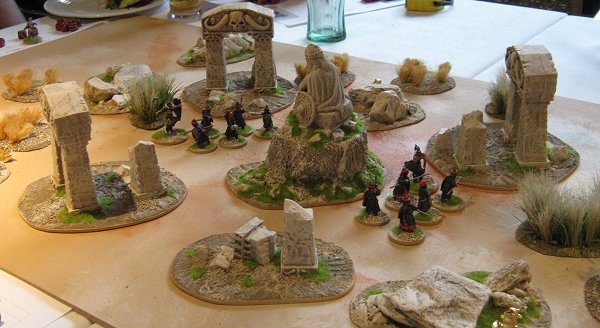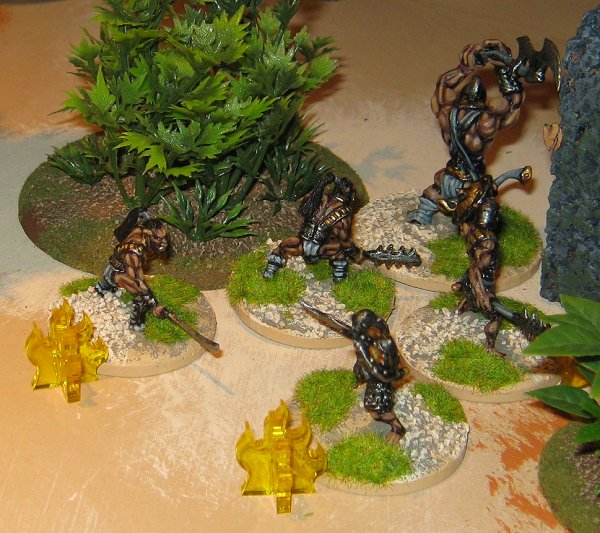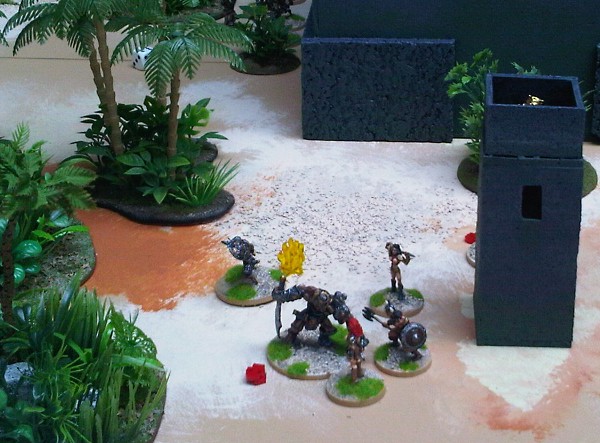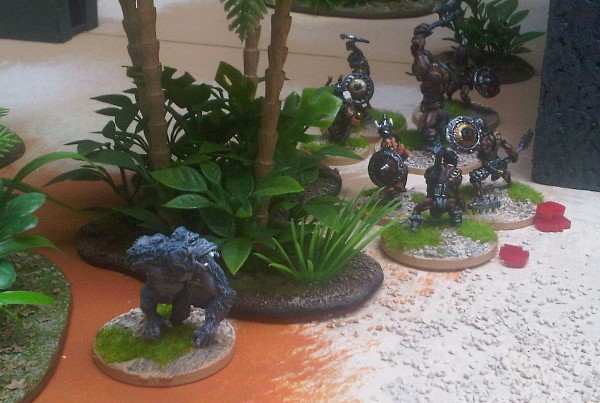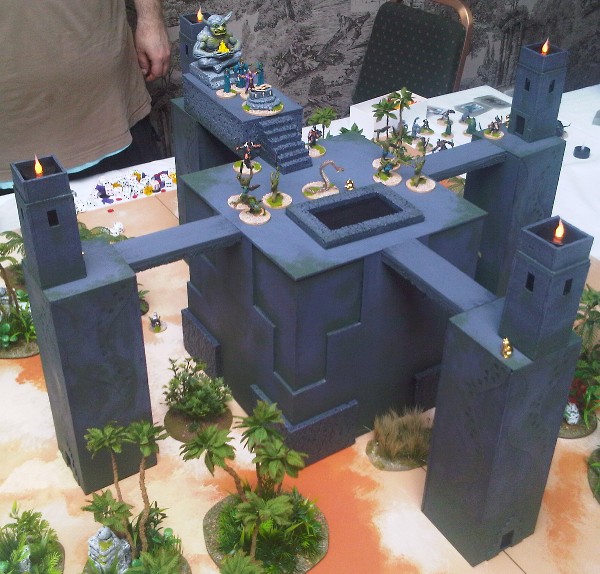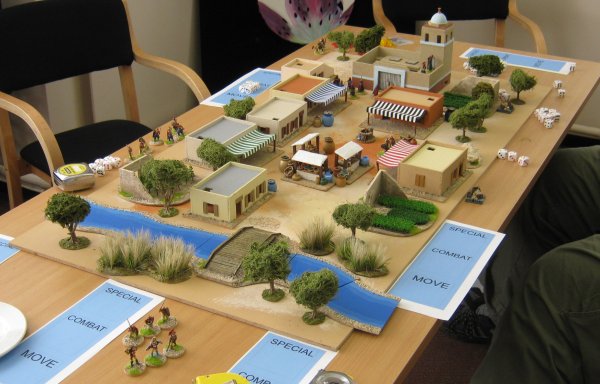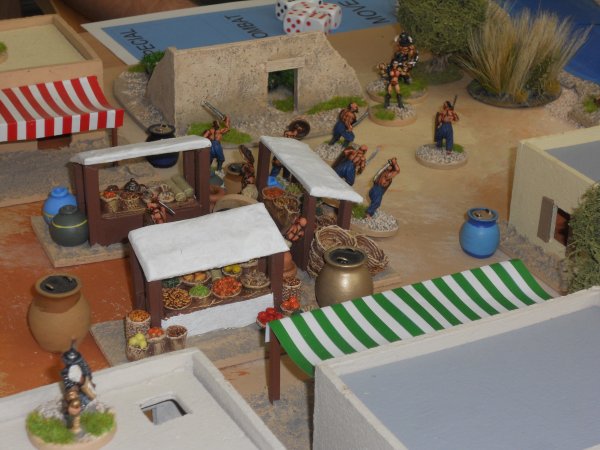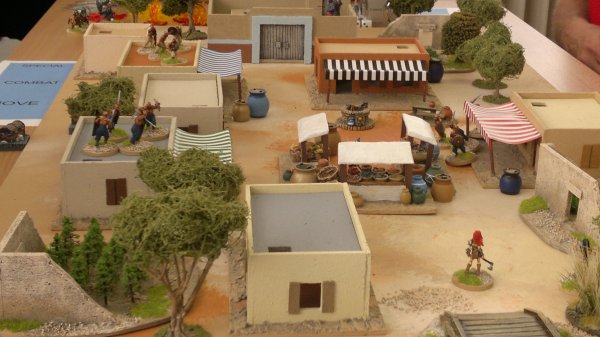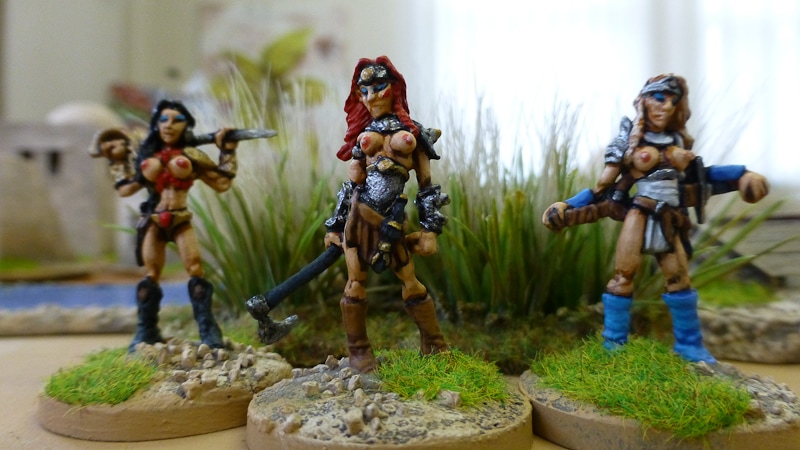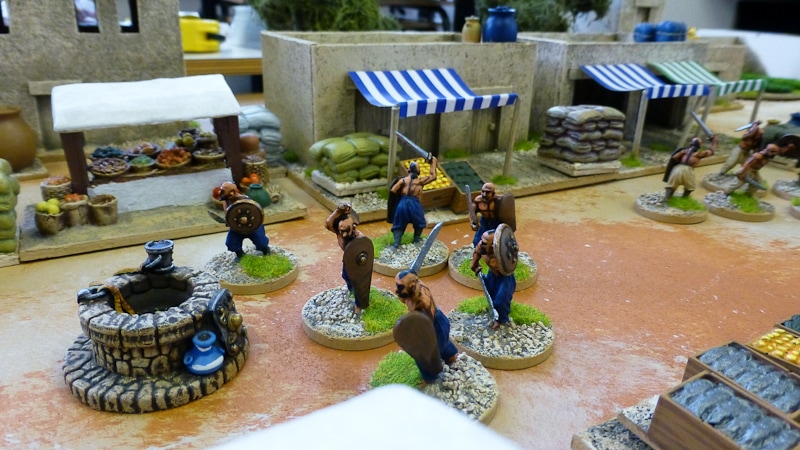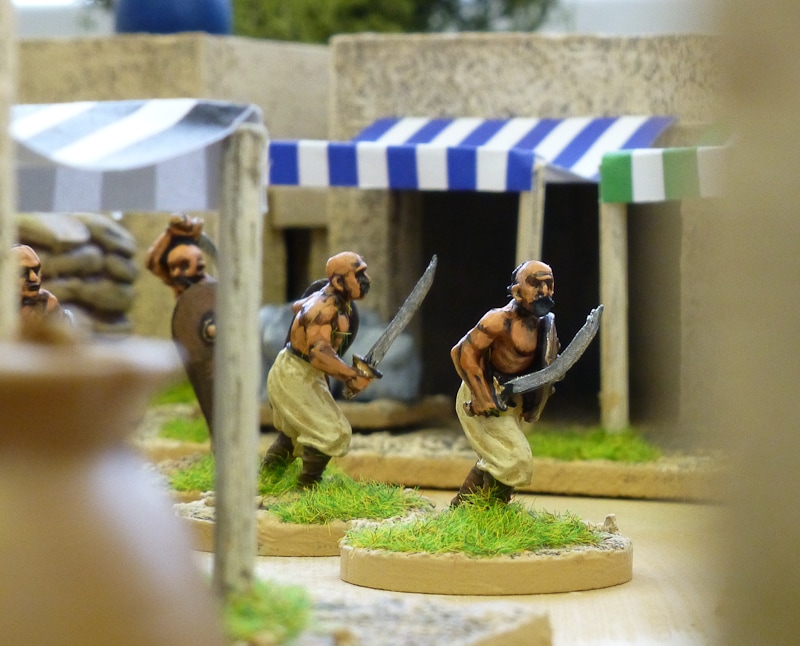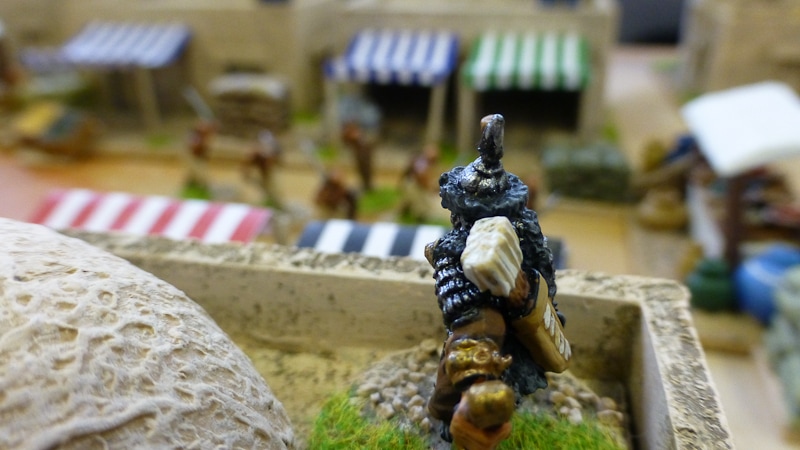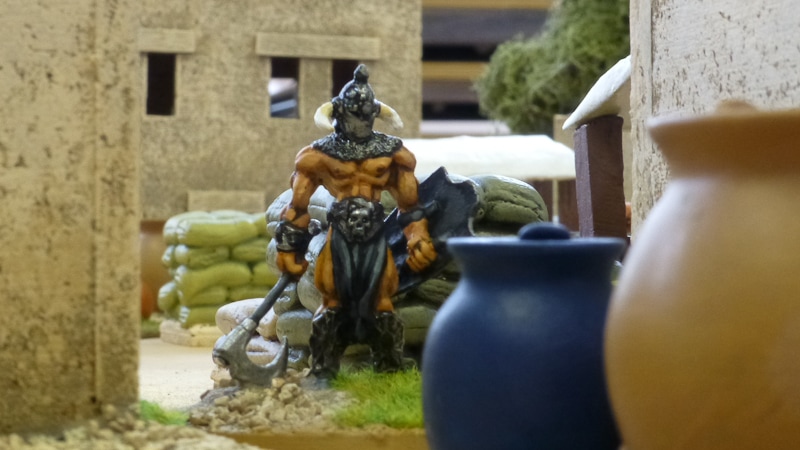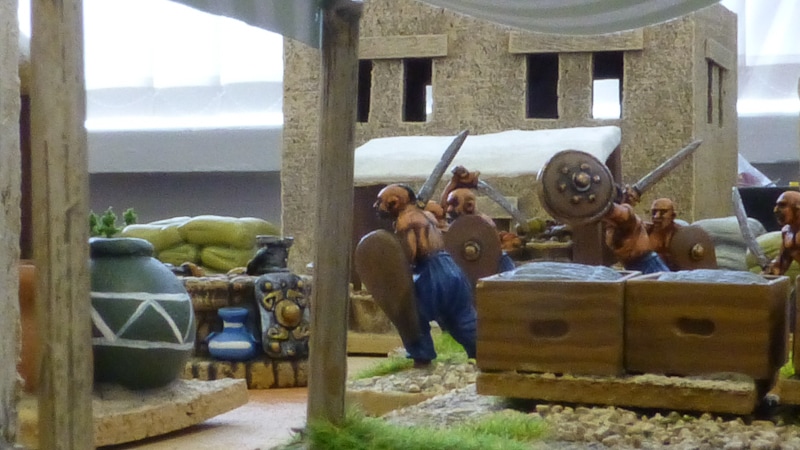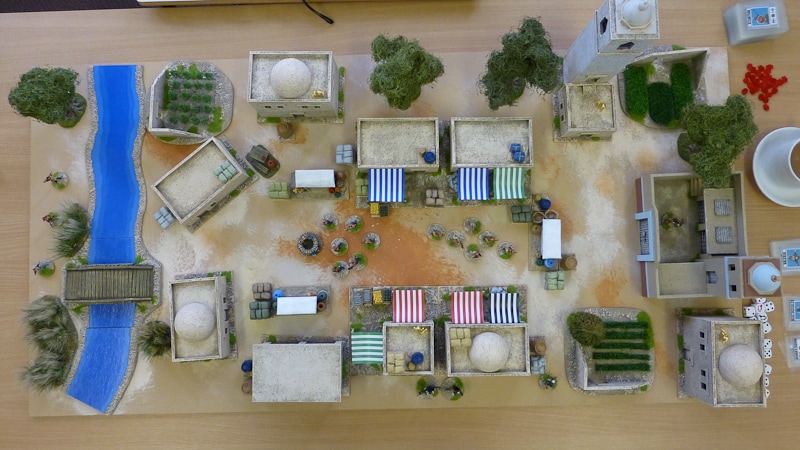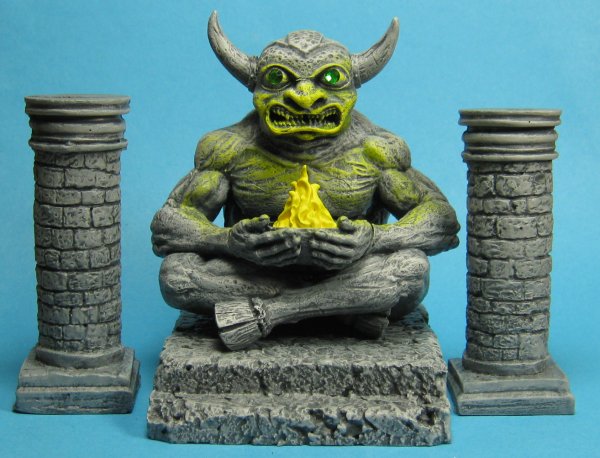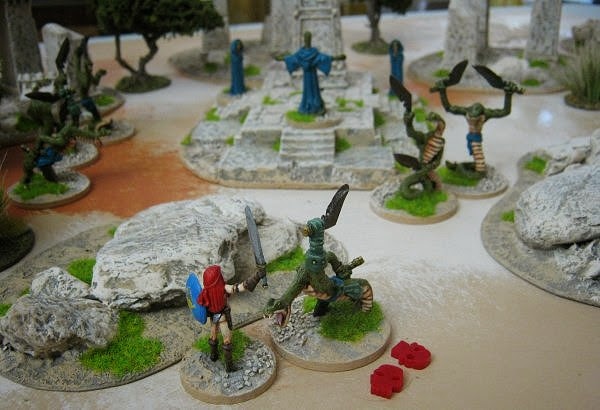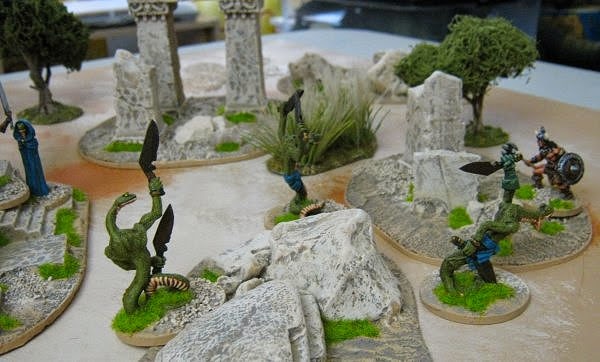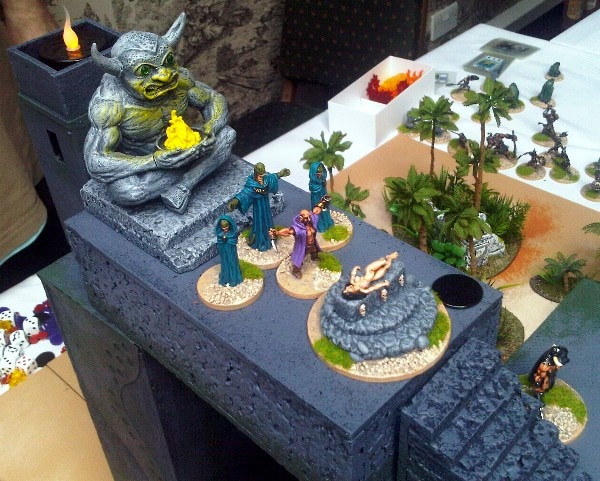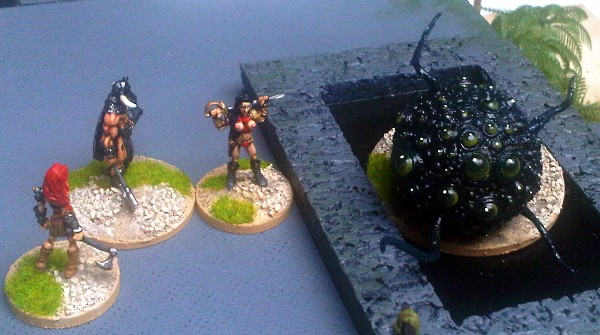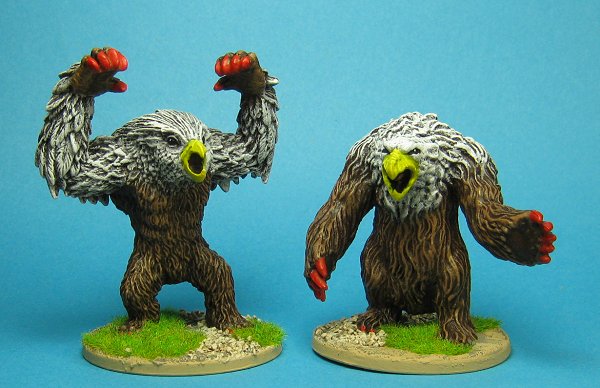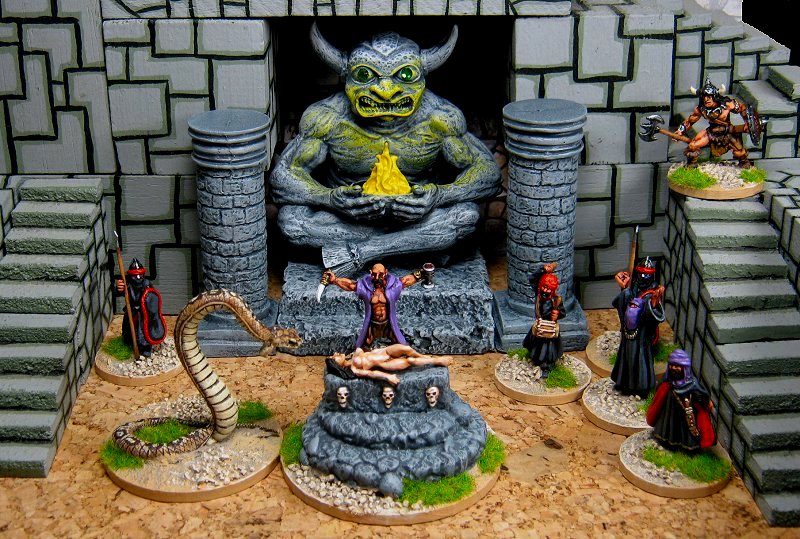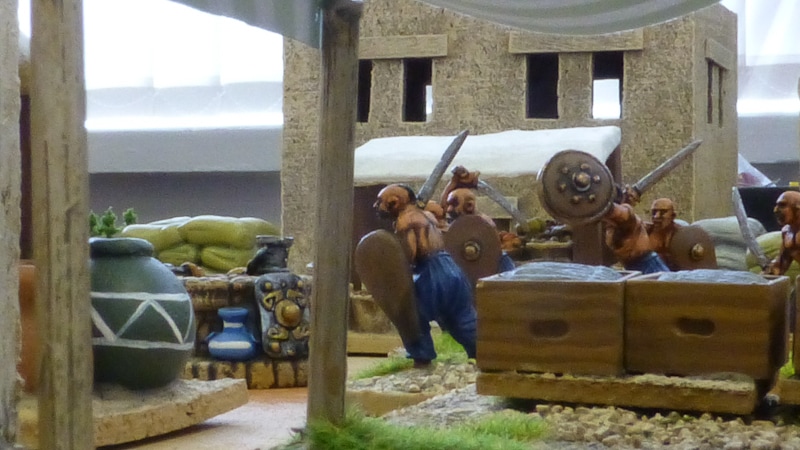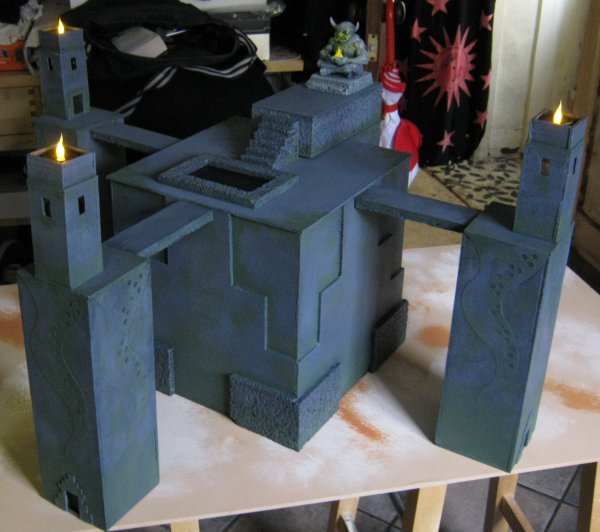|
Explanation
These rules are not complete nor are they laid out as the final version will be. They are presented here so that those who wish may try them out and have a few games with some friends and a few miniatures. The best playing area is about three foot square but really any size will do. feedback is welcomed. Eventually I hope to work these up into a decently produced pdf with diagrams, pictures, illustrated examples, an expanded magic system and lots of scenarios that will be available for a nominal fee. Until then, these will have to suffice. CROM
CROM Is a skirmish game set in the Hyborian Age "...Between the years when the oceans drank Atlantis and the gleaming cities, and the years of the rise of the Sons of Aryas..." that enables players to recreate the stories of Robert E. Howard and similar authors of heroic fantasy. "Hither came Conan, the Cimmerian, black-haired, sullen-eyed, sword in hand, a thief, a reaver, a slayer, with gigantic melancholies and gigantic mirth, to tread the jeweled thrones of the Earth under his sandalled feet." CROM is designed primarily as a multiplayer game but can be played with two players or even solo if desired. One or more players will play heroes, Conan and his companions for instance, and one or more of the other players will play the antagonists, Thulsa Doom, minions, monsters etc. The ideal set up would be three Hero players and a single Antagonist player. Dice Pool
The basic game mechanic in CROM is the dice pool. Each player will have a set number of dice for each of his characters and followers which are allocated at the beginning of each turn between the different action pools that the player wants the character or follower to attempt when it's their go. The basic action pools that dice can be allocated to are: Movement, Combat, Special. Dice may be rolled and totalled or they may be 'burned'. A burned dice is counted as a six but removed permanently form a character's pool. A character's dice pool represents their 'life', specifically their strength and endurance, As a character loses dice either from exertion (burning them) or combat (being hit in combat removes dice) they are able to attempt fewer actions as they weaken and tire. Eventually, if they lose all their dice, they become unconscious, exhausted or even dead depending on circumstances. In any event they are out of the game. When it is their turn a character may attempt actions in any order. They may move, attack an opponent, move again and attack another etc. so long as they have dice remaining to be used. They do not need to use all their dice if they don't want to. Combat dice in particular may be kept in reserve to defend against attacks by others. There are two general types of 'unit' in CROM; characters, represented by a single figure that acts alone, and minions represented by single figures but who activate and act in groups. The following rules are written using characters as examples and the particular differences pertaining to minions will be covered at the end. Treading the jeweled thrones of the Earth under your sandalled feet...
Dice allocated to the movement pool are rolled when the character wishes to move and the total of the rolled dice is the maximum number of inches of distance that can be covered. Movement can be split; i.e. move three dice worth, make an attack and then move a further two dice. However the dice for each distinct move are rolled and totaled separately. For example: Conan wants to rush out, kill a guard and retreat into the shadows before more appear. He has allocated six dice for movement at the start of the turn. He must decide how many of his allocated movement dice he will need to reach the guard, roll them and choose to move or not. The guard is seven inches away, Conan rolls three dice to try and make sure of reaching him but only rolls a total of five. He's short. He can choose not to move (but the dice are used and he doesn't get to use them again this turn) or he can choose to move the five and roll another movement dice to continue or he can abandon this plan and move somewhere else. Conan chooses to roll an additional die and reaches the guard. He kills him and then considers his two remaining movement dice and the safety of the darkness that is seven inches away. Not trusting his luck Conan burns one of his dice to get a six and rolls the other thus ensuring at least a total of seven. Not quite to plan but still successful. Conan's exertion or the stress of the encounter have left him slightly weakened (he loses the 'burned' die from his pool for the rest of the encounter) but he still has plenty of strength left. Movement over rough ground or low obstacles is at half speed, two inches of movement used for every inch of obstruction. Different movement penalties for specific obstacles that may still be crossed must be stipulated at the beginning of the encounter. Figures may move through friendly figures but may not move through opponents. Jumping.
Jumping across gaps can be dangerous. A shallow ditch isn't dangerous if you fall in so wouldn't be represented on the table top in most cases. If it is there at all it's probably just broken ground and costs double. Dangerous obstacles such as deep pits, ravines, spiked traps, building roofs, battlements etc. may have to be jumped across and the action of crossing them can prove fatal or at least harmful if failed. Each inch of dangerous gap requires six inches of movement to cross and for obvious reasons you can't pause mid jump, you have to clear it. Characters may only attempt jumps whose distance is equal or less than half their starting dice total. Conan, cat like Cimmerian that he is, may attempt a massive eight inch jump but he'll be very lucky to make it unless he burns some dice. Minions may attempt a couple of inches or so depending on their type but will baulk at anything more because they are only pathetic lackeys. Jumping down and falling are handled differently. It takes no movement dice to cover the distance but the ground is going to attack you when you land. The ground attacks with one die for every inch of height the character fell/jumped. Results are handled like a normal combat, if the ground wins it inflicts two hits plus another for each six it rolled. Big falls will usually hurt a lot but may be survived by a lucky character. Climbing.
Climbable surfaces will need to be stipulated for each encounter unless it's obvious. Trees are always climbable as are rock faces. Buildings may be scaleable, decide before hand but remember that Conan is an accomplished climber and is probably willing to attempt anything. Climbing is movement at half rate just to keep things easy. Some creatures will climb at normal rate such as spiders but humans generally don't. This makes climbing quite fast but there won't be a lot of it and fractions other than halves are a pain for most people. Feel free to change it on difficult surfaces. Horses.
Horses add six dice to a character's movement pool. Horses can be urged to travel faster by the character encouraging the beast by spending his own dice in addition. Basically a mounted character has more dice available to hit people with and becomes a fearsome warrior indeed. Horse dice can be burned like other dice but one must be kept back- you can't force the animal to kill itself through exertion because this is only a game. Unattended horses may be attacked in which case they do not defend themselves. If it isn't killed outright and isn't tied up it will use any remaining dice to run away immediately. In this fashion horses may be driven off deliberately. A horse being ridden may not be targeted separately except by missile fire or other distance attacks such as magic. Other riding animals, vehicles, magic carpets etc. will add movement dice in a similar fashion. Specifics can be specified for a particular encounter as they won't be a common occurrence. Reaving and Slaying.
A character may make as many attacks as they have dice for against one or more opponents at any time during their turn. Dice allocated to a character's attack pool may be used to either attack or defend with. To attack an opponent the character announces how many dice they will use from those available and the opponent announces how many to use in defence. The dice are then rolled and compared with the higher total succeeding. A successful attack roll inflicts two hits plus one extra hit for every six rolled. A successful defence roll inflicts one hit plus one extra hit for every six rolled. If you don't beat you opponent either in attack or defence the sixes you rolled, if any, are not counted for hits. Only the winner of the roll inflicts damage. Combat rolls that tie are decided in favour of the attacker. Hits received are recorded by removing dice from a character's pool. Unused dice are removed first but if none are available used dice are discarded. The character who received the hit decides which of their dice are to go. For example: Conan has been speared by a guard for a total of two hits (a successful defence with a six rolled, yes Conan failed in his attack). Conan must lose two dice so the player looks at his pools. He has three dice left in movement and four in combat. Conan was hoping to move on and attack another opponent once this one had fallen but since the situation has changed he has to re-evaluate. He decides to lose the dice from his movement pool which means he won't be able to reach a new opponent. No matter, he has four combat dice left and, grinning wolfishly, he uses them to slaughter the guard who winged him. With his single remaining movement dice Conan slips around a corner and ends his turn. However, the damage is done, Conan is a little weaker than he was and next turn he will have two less dice to allocate to his pools. No ganking rule.
If a figure has no dice left to defend itself each opposing figure may only make one further attack against it. Special Actions
This is the catch-all pool for actions that are not moving or attacking. Magic, initiative, missile fire and other tasks are included here that are only available to certain characters. Characters allocate dice to their Special pool declaring what they plan to use them for at the beginning of the turn. Missile fire.
Shooting uses special action dice. To shoot someone a character rolls an attack as normal and the target may roll a defence to dodge or deflect the missile. The target of a shooting attack may use any remaining unused dice from any pool for the defence roll. Cover Hard cover, cover that actually provides some form of barrier protection from a missile attack, removes either one or two of the highest dice rolled (depending on the cover type) before the effects of the shot are calculated. Soft cover, cover that obscures a clear shot in some way but doesn't add any barrier protection such as smoke, removes one or two of the lowest dice rolled (depending on its type). A successful shot scores two hits only, any sixes rolled do not inflict further damage. A successful defence does not inflict hits on the shooter. Initiative.
Initiative order is determined by card draw. Each character or group of minions should have a card prepared for them and these will make up the game deck. Any reinforcements or summoned creatures that arrive after the start of the game should have their cards added to the deck for the turn after they appear. Cards are shuffled and placed face down in a stack. The top card is turned face up and that character takes their turn. Once they're done the next card is turned and so on until the deck is exhausted when the turn ends. Characters will then allocate their dice to their dice pools and the cards are shuffled ready for the next turn. However, sometimes it is important to a player that their character gets to act first. If this is the case they can allocate dice to initiative. Before the top card in the initiative deck is turned face up any characters that have allocated dice to initiative roll them and compare totals. Only characters can do this, minions may not spend dice on initiative. Characters will act in order starting with whoever got the highest total and working down, ties will be re-rolled. Once all the characters who allocated initiative dice have completed their turns the initiative deck is used as normal. When the card for a character that has already acted appears it is just ignored, that character doesn't get a second go, and the next card is drawn. Magic.
There is quite a bit of magic floating about in Conan's world and most of it is unpleasant. For now only summoning magic will be covered but later on more will be added. Summoning and Controlling. Summoned creatures are a good way for a weedy Wizard to hurt people. They're also a good thing for sullen-eyed Barbarians to slay for glory and profit and so may well make regular appearances in encounters. To summon a creature a Wizard must burn dice allocated to his Magic pool until he has filled the dice pool of the creature he wishes to summon at which point it will emerge into the summoner's reality usually accompanied by unpleasant smells. Magic dice burned in summoning are regained at the rate of one a turn until they have all been recovered. Wizards summon at different rates. The best Wizards may give one dice to a creature for every two they burn. Lesser Wizards will have a conversion rate of three to one or even worse. Big cults of Nameless Gods might require a sacrifice of a life to donate a single dice. For example: Thulsa Doom wishes to summon a Worm of the Earth which has a dice total of ten. Doom is a major Wizard and his conversion rate for magic is two for one (which is the best you can get) so he must burn twenty magic dice to give the Worm its ten and summon it. Doom only has ten dice himself so he needs to consider his options. He could sacrifice a maiden for extra dice (more on this at a later date) but he doesn't have one to hand. He could enlist some junior Wizards and they could work together pooling their resources but he prefers to work alone. His only option is to take his time about it. Luckily for Doom, Wizards that burn Magic dice regenerate one dice a round until they have regained all that they spent. If he spends nine of his ten straight off and then uses the one he gets back each turn he'll have a Worm of the Earth ready to serve him in only twelve turns. Lets hope a big barbarian doesn't come crashing through his door mid ceremony and interrupt him. Controlling.
Once a Wizard has summoned an entity he must attempt to control it or it will just run amok attacking the nearest person. To control a creature a wizard must spend enough magic dice to roll a total equal or higher than the creature's starting dice total. To control the Worm of the Earth in the above example Thulsa Doom would need to roll ten or more. You'll have realised no doubt that leaving himself with only a single Magic die as the creature appears isn't enough to control it so he'll need to take more time over the summoning to allow his dice reserves to build up. Dice spent to control a creature are not burned (they may be voluntarily burned to ensure sixes of course) and are available on subsequent turns just as dice allocated to movement or combat are. Wizards are only allowed a single control attempt which is taken immediately the creature appears at the completion of a successful summoning. A success will allow the Wizard to dictate the actions of the creature including allocating its dice at the beginning of a turn. Failure means the creature is out of control and probably hungry. Only major Wizards can control summoned creatures. Should the Wizard subsequently be incapacitated or killed the summoned creature will revert to being uncontrolled on the next turn. Other Magic.
The options for magic in CROM are really only limited by your imagination. The basic idea is that a wizard will allocate special dice to magic actions and either attempt to overcome an opponent's defence roll or reach a target number to succeed. However using magic is extremely tiring so magic dice are discarded once rolled and are not available for use again until they have been recovered. Most magicians will recover one die each round unless they are very special or have items that help with their magic regeneration. Magic dice may be burnt to ensure sixes as with any other actions and of course these burnt dice will not be recovered. Here are the magic action that Mako can do as standard to give you some examples: Fire attack: Line of sight, defender may use any dice to resist. 2 hits for a successful attack and target is on fire if a 6 is rolled. Defend other: Line of sight, may place a combat shield around a friend that gives 1 defence die for each 6 points Mako rolls initially. These die are used first in defence and used up when used. Heal: Line of sight, may heal 1 die on the target per 2 dice spent. Heal poison: 12 points of special dice will heal poison if adjacent to character. Fire: 6 points of special dice will extinguish a fire if adjacent to it.(This is easier than physically extinguishing the fire). Cover does not affect spell casting. Targeting most figures carries little risk to a magic wielding character and so their spell effects are not especially spectacular. However, targeting another wizard carries quite a bit of risk and is handled differently. A magic attack against another magic user is carried out exactly like a hand to hand combat even though it is occurring at range. A successful attack inflicts two hits plus one for each six scored. A successful defence inflicts one hit plus one for each six scored. Only special dice may be used to defend against this sort of attack and they are discarded as if the defender had cast a spell. Other Tasks.
There are times when characters will need to accomplish tasks that don't involve moving and killing (yes, really). Locked doors will need to be smashed in or the locks picked, traps will need disarming, prisoners will need freeing, grappling hooks will need accurately throwing etc. Tasks of this complexity, tricky but within the normal abilities of an adventuring hero, require a score of six to achieve. This allows a character to roll a few Special dice if they can afford to risk a failure or to burn a dice and succeed if they're in a hurry. Very difficult tasks may need a score of twelve but these will be very rare. Minions.
Minions are activated in groups. They have low set dice totals for moving and combat (usually two for each) and the controlling player decides what they're going to do when their card is drawn. Generally minions can't do anything other than move, fight and die for their master. They should operate in groups of three to five. One set of movement dice is rolled for the group of minions and each minion in the group may move up to that total distance. Minion combat rolls are made separately for each minion. Minions with different dice pool totals. Basic minions have two movement dice and two combat dice and each hit against them removes a die from each pool. Minions who are more powerful are handled in a similar way. Each hit against them will remove a die from their highest rating first (combat) until this has dropped to equal their next highest total (movement). After this each hit will remove a die from both pools. Poison
Venomous creatures such as large snakes and spiders will poison an opponent with a successful attack (not defence) that includes at least one six. Once a character or minion is poisoned the figure should be marked to denote this (usually a poison counter, perhaps a tiny spider or snake) and a poison card is added to the action deck at the beginning of the next round. When the poison card is drawn any figure who has a poison marker receives a single automatic hit. Poison markers may be removed with an antidote or magic healing. Any antidotes should be described in the scenario notes, they are not common. If no cure is available a character or minion must hope to hold out to the end of the encounter when better aid can be administered by friends. poison effects should not normally carry over from one encounter to the next. If a figure has a poison counter it will not receive another if it is poisoned again. Fire
Characters and minions may be set alight by several means, magic is probably the most usual in an encounter, but mundane fires can spread as well.spreading fires will be covered later. A magic fire attack uses dice from the magic pool and is carried out like a missile attack inflicting two hits if it is successful. In addition, if the attack contained one or more sixes the target will be set on fire. Once a figure is on fire it must be marked somehow to denote this and a fire card is added to the action deck at the beginning of the next turn. When the fire card is drawn any figures on fire receive two automatic hits. If a figure has a fire counter it will not receive another if it is ignited again. Fire markers may be removed in a variety of ways. Immersion in water will remove it automatically otherwise extinguishing a figure on fire is a special action with a target of 12. Only one extinguishing attempt a round may be made for each fire. Water in decent quantities that isn't enough to allow immersion adds a die to the attempt as does anything else that may help, blankets etc. (these dice are rolled, not burnt). |

